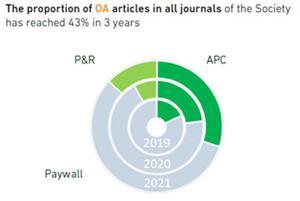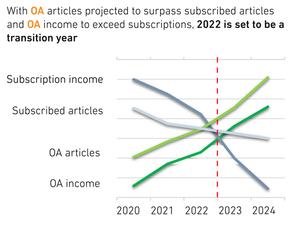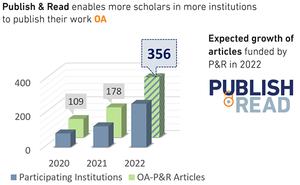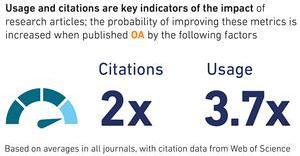Publishing for the Community: Transition milestones – our Open Access journey
Issue: Engaging Microbiology
17 May 2022 article

Our focus at the Society has always been publishing for the community – where the income generated from our journals is returned to support activities that benefit all.
In its 75th year, we prepare for the Society’s founding journal, Microbiology, to become fully Open Access (OA) in 2023. A fully Open Access Microbiology benefits our membership, all microbiologists and anyone interested in microbiology, and ensures that our authors are completely funder compliant. At this turning point in our publishing history, we look back on two years of unprecedented progress and look forward to charting the milestones as our publishing programme becomes predominantly OA, shifting from our reliance on subscriptions.

OA growth
In 2021, 43% of all articles published across the portfolio were immediately made OA, either through payment of an Article Processing Charge (APC) or funded by a Publish and Read (P&R) transformative agreement. As shown in the figure below, we have seen significant year-on-year growth (38% more in 2021 than 2020) in the proportion of OA publishing in our journals, putting us on track to exceed an important benchmark – to publish more OA articles than paywalled articles in 2022. As we succeed in bringing more institutions to our Publish and Read programme, OA growth will be further fuelled by institutional financial support, relieving authors of the need to fund their publication costs.

Looking forward, our ambition over the coming years will be to ensure publishing for the community – where the income generated from our journals is returned to support activities that benefit our community – can be delivered transparently and sustainably. Our data suggest that the number of OA articles published will overtake those coming from subscriptions. In addition to this, the income generated from OA models is forecasted to exceed subscriptions over the next renewal cycle, when Microbiology flips fully to OA.
Over the mid-term of the next three–five years, we will be working to increase article output in all titles across the portfolio. The strongest driver of that growth will be in OA publishing, providing a solid base for a sustainable OA future.
The success of the Society’s Publish and Read model

The expansion of Publish and Read since 2020 has been a driving force of OA growth. In 2022, the Society has for a second year doubled the number of institutions benefiting from this model, achieving two of our key objectives.
Firstly, an ever-increasing number of authors benefit from fee-free OA publishing. Secondly, it drives OA publishing away from a currently APC-dominated model with the associated barriers it presents to authors who struggle to raise the funds themselves, a burden that disproportionately affects early career researchers.
As more institutions participate, we can predict a relative increase in the number of OA articles funded through this model and hope to celebrate the doubling of OA output again compared with 2021.
OA impact

In recent years, reviews published in scholarly communications literature on the citation advantages, and therefore on the visibility and impact, of OA have produced varied conclusions. From analysing our 2020 and 2021 article performance data, we found that OA articles on average receive twice as many citations and 3.7 times the level of usage (views and downloads) as paywalled articles. Whilst not comparable to some wider, more rigorous studies, the figures from our portfolio do indicate an enhanced probability of higher impact and enhanced visibility of articles published OA. We encourage all our authors who publish OA to take full advantage of the easy ‘share’ options offered by our publishing platform.
Actions to achieving a fully Open future
Our priority as a Society publisher is for OA to become the predominant path to publishing research in a way that is both sustainable and serves the needs of microbiology researchers worldwide. As we continue to innovate by transforming our journals, our plans over the next few years are to:
- Improve inclusivity, benefitting more authors in more regions.
- Build more OA funding routes to spread publication costs.
- See our first hybrid title, Microbiology, flip fully OA in 2023.
- Innovate with new open science initiatives such as the open research platform Access Microbiology.
A key ingredient to our success has been collaborating with others who are similarly traversing the route to OA, including the not-for-profit publishers of the Society Publishers’ Coalition. The self-publishing societies within the Coalition came together to create a scalable, cost-neutral model based on ‘Unlimited OA’ publishing, and this has created the best conditions for libraries and consortia groups to put their trust and budget into a collective endeavour.
We aim to align ourselves with the OA ambitions and agendas of research institutions worldwide, ensuring that inclusive, open and equitable practices persist for the next generation of microbiologists.
Jade Heyman
Journal Sales and Transformation Manager
[email protected]
“Showing a clear commitment to an open, transparent, and sustainable scholarly communication environment, the Microbiology Society is one of the pioneers in the transition of paywall-based scholarly publishing to open access.”
Head of Information, Max Planck Digital Library, a Publish & Read partner since 2021


